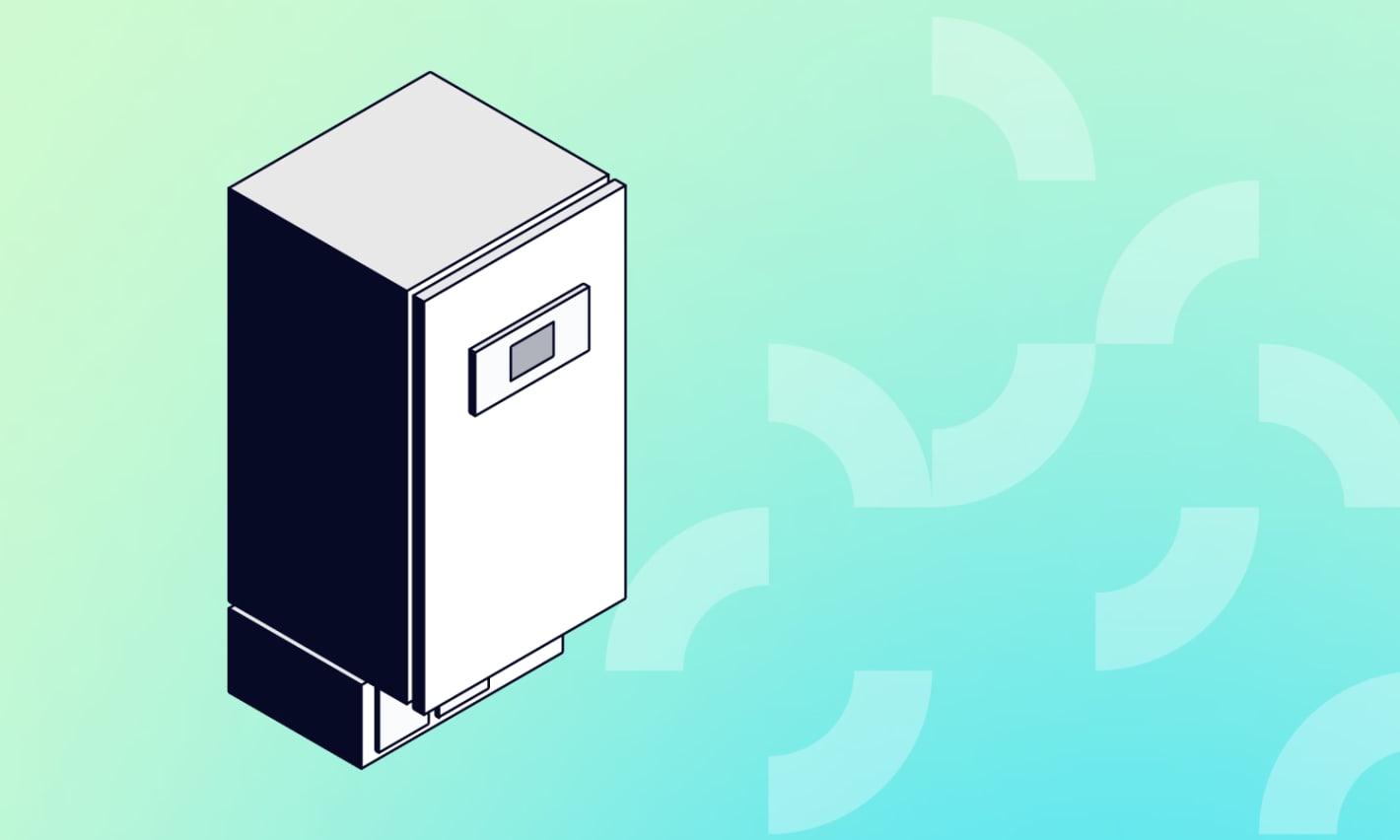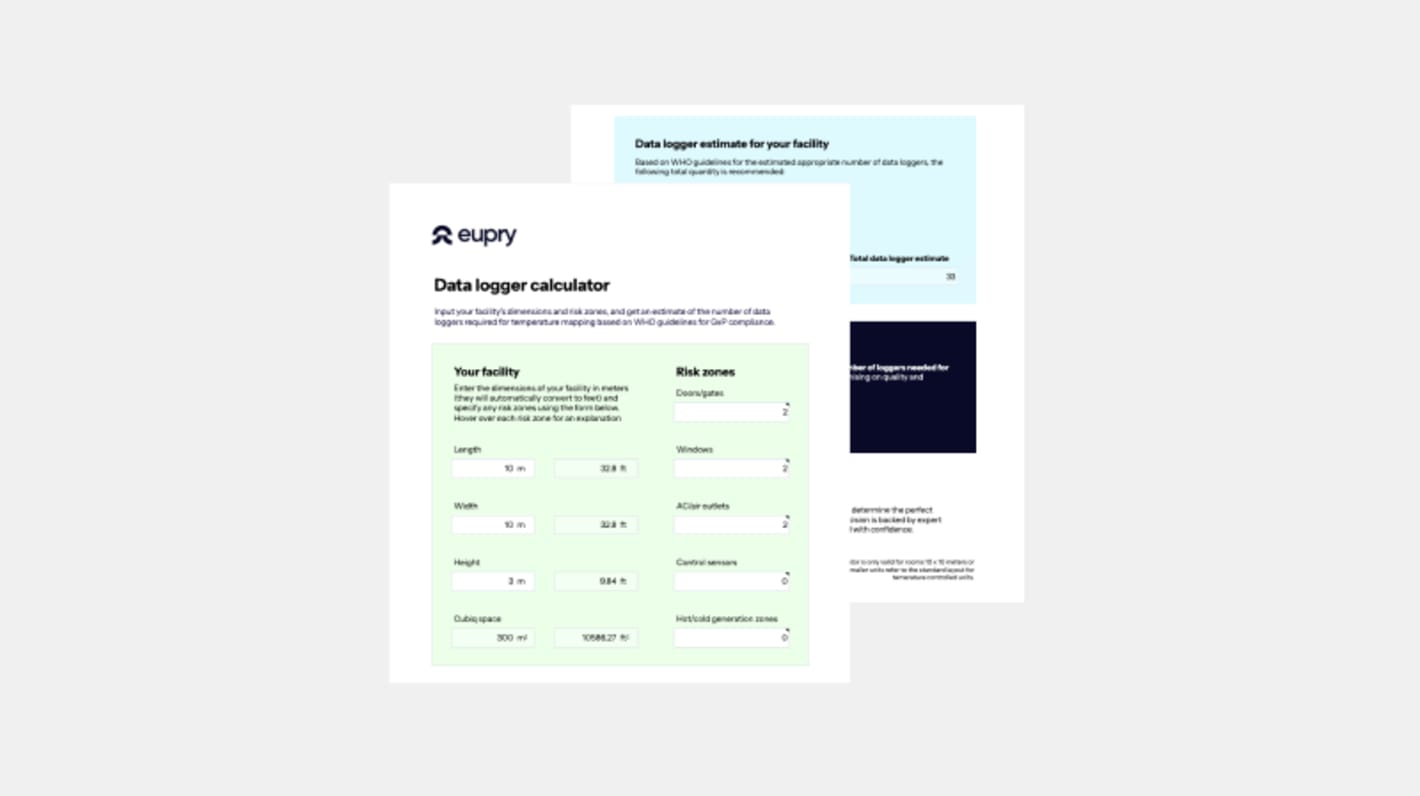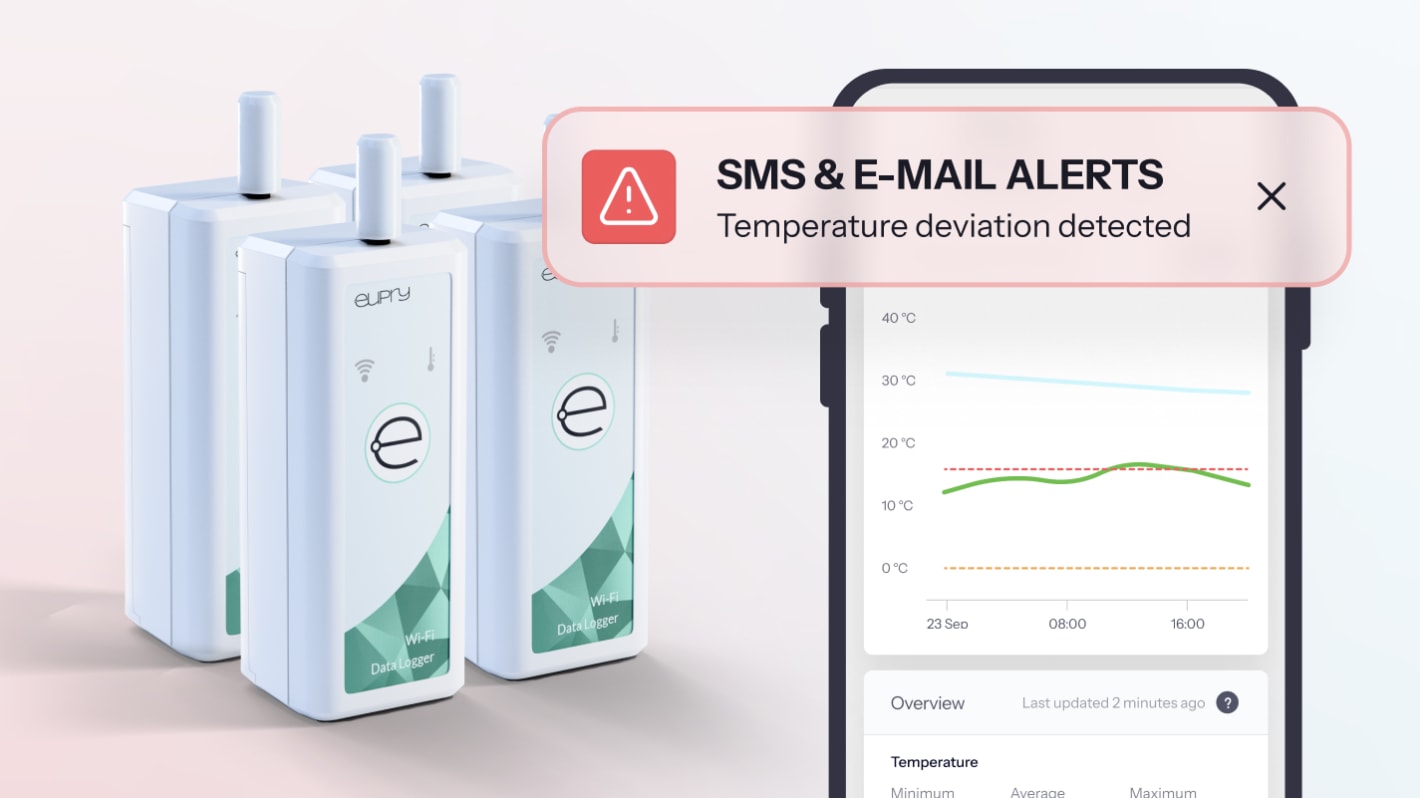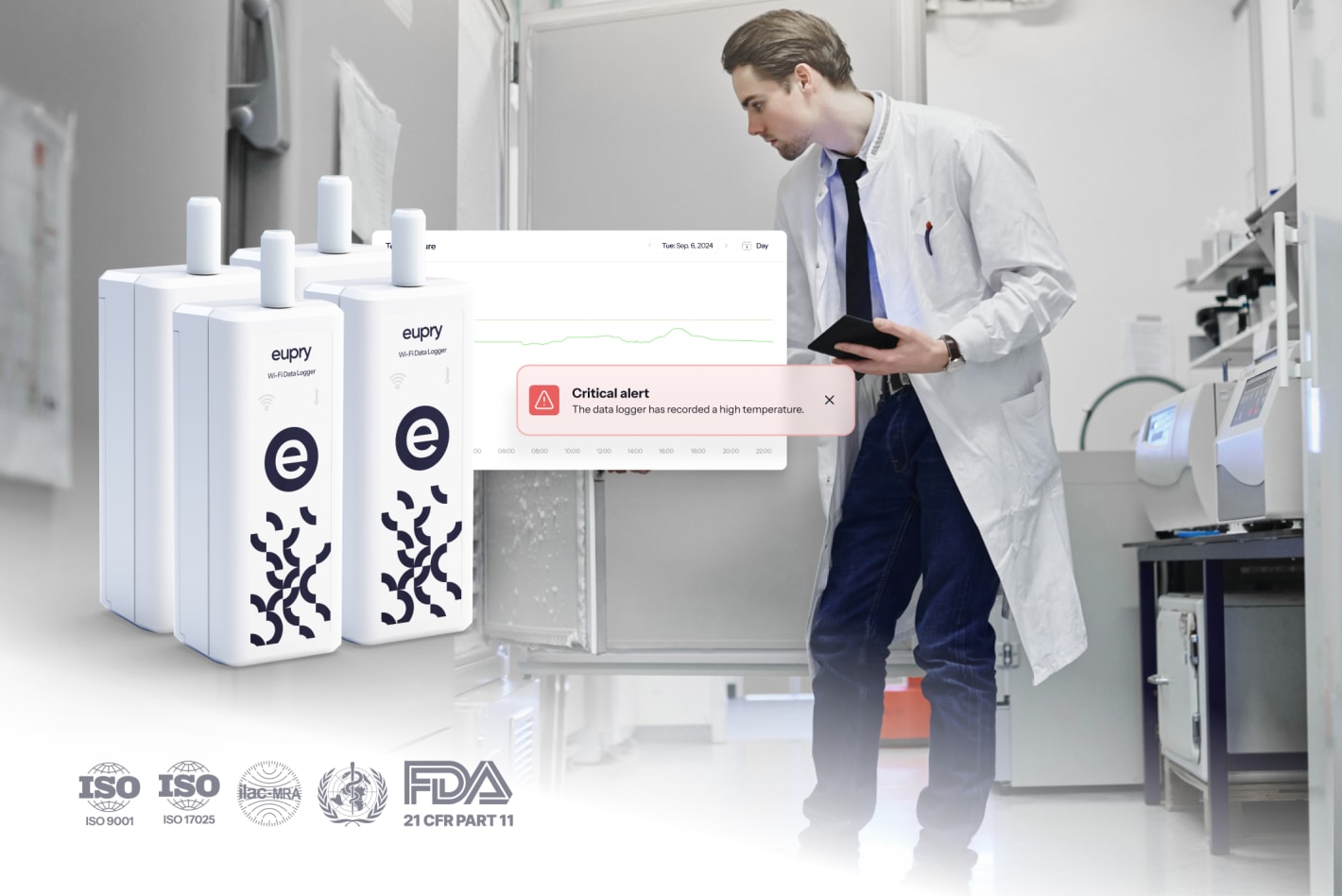ULT and freezer qualification and validation for pharma

Adam Hartmann-Kruckow
Learn how to qualify and validate pharmaceutical freezers (ULTs and standard) under GMP/GDP – from IQ/OQ/PQ protocols to temperature mapping, continuous mapping, and audit preparation.

Quick answer
Freezer qualification verifies that ultra-low temperature (ULT) freezers maintain required storage conditions through three phases: Installation qualification (IQ), operational qualification (OQ), and performance qualification (PQ). Temperature mapping proves uniformity, while continuous mapping eliminates periodic re-mapping by providing ongoing compliance evidence.
Pharmaceutical and biotech organizations rely on freezers to store temperature-sensitive products - from vaccines and biologics at -20 °C to cell therapies and critical samples requiring ultra-low temperatures (e.g. -80 °C). Whether maintaining standard pharmaceutical freezers or ULT units, validated storage systems that meet GMP and GDP requirements are essential to protect product integrity.
Freezer qualification proves that a storage unit consistently maintains required temperatures under all operating conditions. This process follows regulatory guidance from GMP Annex 15, WHO TRS 961 Annex 9, USP <1079>, and ISPE Good Practice Guide: Cold Chain Management and applies to all freezer types used in regulated environments.
This guide explains how to qualify freezers correctly, perform compliant temperature mapping, and implement continuous mapping to maintain audit-readiness throughout the equipment lifecycle.
Also see: IQ, OQ, PQ services for GDP and GMP
What is freezer qualification, and why is it required?
Freezer qualification verifies that a pharmaceutical freezer maintains controlled storage conditions as specified in GMP and GDP requirements. It provides documented proof that the equipment operates correctly and protects product integrity throughout its lifecycle.
Also read: Complete guide to thermal validation
Qualification follows a three-phase approach established in GMP Annex 15 and WHO TRS 961 Supplement 7:
Installation qualification (IQ)
IQ verifies that the freezer is installed correctly and matches specifications in the URS. This phase confirms the physical setup before any operational testing begins.
IQ verification includes:
- Equipment model, serial number, and location documentation
- Utility connections: power supply, backup systems, exhaust ventilation
- Sensor installation and initial probe placement
- Safety features: door alarms, temperature alarms, emergency contacts
- Documentation review: manuals, drawings, calibration certificates
Key question IQ answers: Is the equipment installed as specified and ready for testing?
Also read: IQ, OQ, PQ in pharma: Guide to equipment qualification
Operational qualification (OQ)
OQ tests the freezer's functional performance under controlled conditions. This phase demonstrates that all systems operate within defined limits before introducing product or routine use.
OQ testing includes:
- Temperature distribution mapping (empty chamber)
- Alarm function testing: high/low temperature, door ajar, power failure
- Recovery time after door opening
- Defrost cycle impact (for auto-defrost units)
- Control system verification: setpoint accuracy, display calibration
Key question OQ answers: Does the freezer function correctly under test conditions?
Performance qualification (PQ)
PQ proves the freezer maintains controlled conditions under actual operating scenarios. This phase includes loaded storage tests and stress conditions that simulate real-world use.
PQ testing includes:
- Temperature mapping under representative load
- Worst-case scenarios: maximum door openings, power interruption, seasonal ambient variations
- Stability testing over extended periods (typically 24–72 hours)
- Holdover time determination (time to exceed limits during power loss)
Key question PQ answers: Does the freezer maintain compliance during normal operations?


Download a free IQ/OQ/PQ protocol pack
Get instant access to an all-in-one protocol pack: From URS checklists to IQ, OQ, and PQ protocol templates. All you need to plan the qualification of temperature-controlled equipment and environments in pharmaceuticals, biotech, and logistics, aligned with WHO, FDA, GMP/GDP/GxP guidelines.
How do you perform temperature mapping for a freezer?
Temperature mapping is a critical stage in freezer qualification. It provides verifiable proof that the temperature remains uniform throughout the storage space and that no critical points fall outside acceptable limits. This practice is reinforced by WHO TRS 961 Annex 9, ISPE Good Practice Guide: Controlled Temperature Chambers, and USP <1079> guidance on storage and shipping practices.
Also read: What is the difference between temperature mapping and validation?
How many data loggers do you need for freezer mapping?
The number of data loggers depends on freezer size, internal configuration, and risk assessment. WHO TRS 961 guidance recommends arranging loggers in a grid pattern covering the width and length of the area, with loggers positioned every 5–10 meters.
Also read: Choosing temperature mapping data loggers and equipment
Grid-based placement approach:
- Small freezers: Minimum 3×3 vertical grid (9 loggers) covering corners, center, and edges
- Medium walk-in freezers: 5×3 to 5×4 grid (15–20 loggers) ensuring comprehensive coverage
- Large freezer rooms: Grid spacing every 5–10 meters horizontally plus vertical layers
Risk-based additions beyond standard grid:
- Near door seals (high variability zone from warm air intrusion)
- Back wall and floor (typically coldest zones)
- Top shelves or ceiling height (potential warm spots in upright models)
- Center of loaded product mass (slower temperature recovery)
- Adjacent to refrigeration components or air outlets
All loggers must be calibrated to ISO 17025 standards with valid certificates covering the target temperature range.
Learn more about placing data loggers for temperature mapping

Where should you place temperature loggers in a freezer?
Logger placement follows a three-dimensional grid that captures temperature variation across height, width, and depth. The goal is to identify extremes and verify that all zones remain within acceptance criteria.
Standard grid approach:
- Divide the chamber into horizontal layers (top, middle, bottom)
- Within each layer, place loggers at corners, center, and mid-points
- Add loggers near the door, back wall, and any obstructions (shelves, racks)
- For loaded studies, place loggers between product containers at representative depths
High-risk zones requiring additional monitoring:
- Door area: experiences warm air intrusion during access
- Compressor side: may show temperature cycling during defrost
- Top shelf: warm air rises, creating potential hot spots in upright freezers
- Center of load: slowest to recover after disturbances
After mapping identifies hot and cold spots, permanent monitoring probes should be placed at these extremes to provide ongoing compliance verification.
Also see: Guidelines for risk-based temperature mapping in GxP
How long should mapping studies run for ULTs and standard freezers?
Mapping duration must be sufficient to capture normal operating cycles and demonstrate temperature stability. Most studies run 24–72 hours, depending on the freezer type and operational complexity.
Minimum duration guidelines:
- Empty chamber (OQ): 24 hours minimum
- Loaded chamber (PQ): 48–72 hours recommended
- Include at least one defrost cycle (for auto-defrost models)
- Extend duration for walk-in freezers or complex storage configurations
Event testing to include:
- Door opening and recovery: simulate normal access patterns
- Defrost cycle: verify temperature remains within limits
- Power failure simulation: measure holdover time and recovery
- Ambient temperature variation: map during the warmest season ifthe climate-controlled space varies
Data must be recorded at intervals that capture short-term fluctuations–typically every 1–15 minutes for freezers, with shorter intervals (1–5 minutes) recommended for ULT units given their sensitivity to thermal events.
Also see: Guidelines for freezer mapping
What are the acceptance criteria for freezer mapping?
Acceptance criteria define the temperature limits and uniformity standards that demonstrate compliant performance. Criteria must align with product storage requirements, stability data, and regulatory commitments.
Standard acceptance criteria elements:
- Temperature range compliance: All zones remain within specified limits (commonly ±3 °C of setpoint, though tighter tolerances apply for high-risk products)
- Maximum temperature: Does not exceed product stability limit or labeled storage maximum
- Recovery time: Return to setpoint within defined time after disturbances (typically 15–30 minutes after door opening)
- Temperature uniformity: Difference between the hottest and coldest zones should be documented and justified based on product risk
- Alarm activation: High/low alarms trigger before excursions exceed acceptable duration
Acceptance criteria should be defined before mapping begins and documented in the protocol. WHO TRS 961 notes that some mapping studies may be performed without predefined criteria to establish what products can safely be stored and what improvements are needed.
Mapping report requirements:
Mapping reports must document raw data, statistical analysis (mean, standard deviation, minimum/maximum per zone), identified hot and cold spots, deviations with corrective actions, and recommendations for sensor placement and storage zones.

Temperature mapping report template
Develop a cohesive and actionable mapping report for pharma, biotech, and logistics with this detailed temperature mapping report template including practical examples.
Which tests are required to qualify a freezer?
Freezer qualification includes operational tests that verify performance under both normal and stress conditions. These tests align with GMP Annex 15, WHO TRS 961, and USP <1079> standards and demonstrate that the equipment maintains controlled storage throughout its operational range.
Which tests are required during freezer qualification?
- Power failure test: Evaluates holdover time and recovery after power loss
- Door-opening test: Measures temperature stability under normal access patterns
- Defrost cycle test: Confirms minimal variation during automated defrost cycles (for auto-defrost models)
- Uniformity test: Assesses consistency across shelves and compartments under loaded conditions
Guidance from GMP Annex 15, WHO TRS 961 Supplement 7 (Qualification of Temperature-Controlled Storage Areas), and USP <1079> inform test protocols and acceptance criteria for storage equipment qualification.
Power failure and holdover testing
Power interruptions are inevitable. Holdover testing determines how long a freezer maintains acceptable temperatures without power, which informs emergency response procedures.
Test procedure:
- Disconnect the power supply to the freezer at normal operating temperature
- Monitor internal temperature at multiple locations
- Record time to reach the upper acceptance limit
- Restore power and measure recovery time to the setpoint
Documentation requirements:
- Holdover time (time from power loss to excursion)
- Recovery time (time from power restoration to compliant temperature)
- Ambient temperature during test
- Freezer load conditions (empty vs representative load)
Results guide emergency protocols and backup power specifications. Many organizations target a 4–8 hour holdover for ULT freezers to allow time for corrective action.
Door opening and recovery testing
Routine access introduces warm air and disrupts thermal equilibrium. Door opening tests establish acceptable access patterns and inform standard operating procedures.
Test procedure:
- Open the door for a defined duration (30 seconds, 1 minute, 5 minutes)
- Monitor temperature rise at multiple locations
- Close the door and record the recovery time to the setpoint
- Repeat at different load levels and ambient conditions
Typical acceptance: temperature rise ≤10 °C during brief access (30–60 seconds) with recovery to setpoint within 15–30 minutes.
Defrost cycle testing
Auto-defrost freezers periodically warm the evaporator to remove frost buildup. Defrost testing verifies that the chamber temperature remains controlled during these cycles.
Test procedure:
- Initiate defrost cycle (manual or automatic)
- Monitor chamber temperature continuously
- Verify temperature stays within acceptance limits
- Confirm normal operation resumes after the cycle completes
Some ULT models use vacuum or low-temperature defrost systems that minimize thermal impact. Testing must reflect the actual defrost mechanism in use.
Uniformity and stability testing
Long-term stability testing demonstrates consistent performance over extended periods under loaded conditions. This test typically runs 48–72 hours and forms the core of PQ evidence.
Test procedure:
- Load freezer with representative product mass (or thermal simulant)
- Record temperature continuously at all mapped zones
- Include normal operational events (door openings, defrost cycles)
- Verify all zones remain within acceptance criteria throughout study
Statistical analysis must demonstrate stability (low standard deviation) and uniformity (minimal zone-to-zone variation).
Also read: How to create a temperature mapping protocol in pharma
What calibration is required for freezer temperature sensors?
All temperature sensors–whether used during mapping studies or for continuous monitoring–must be calibrated by accredited laboratories. ISO 17025 accreditation demonstrates technical competence and traceability to national or international measurement standards (NIST, NPL, PTB).
Also read: ISO 17025 in temperature compliance: What you need to know
ISO 17025 calibration requirements for freezer sensors
Calibration requirements:
- Frequency: annually or per manufacturer specification
- Range: must include target operating temperature (e.g., –80 °C for ULT freezers)
- Uncertainty: maximum error ±0.5 °C at each calibration point per WHO TRS 961 guidance
- Traceability: certificate showing connection to recognized reference standards (NIST, NPL, PTB)
- Documentation: sensor ID, calibration date, due date, certificate reference
Expired or out-of-tolerance sensors invalidate associated data. Calibration management systems track due dates and prevent use of uncalibrated equipment.
How to maintain calibration traceability
Calibration traceability connects each measurement to a recognized reference standard through an unbroken chain of calibrations. This linkage is essential for regulatory compliance and data defensibility.
Traceability documentation:
- Calibration certificate showing sensor ID and calibration date
- Reference standards used (with their calibration dates)
- Calibration laboratory accreditation status
- Measurement uncertainty at each calibration point
- Connection to national measurement institute (NIST, NPL, PTB)
During audits, inspectors verify that sensors used for qualification or monitoring have valid, traceable calibration at the time of use.
Reduce the time you spend on calibration by up to 95%. Handle all calibrationss in minutes, directly at your site, without changing data loggers.

What does Annex 11 and Part 11 compliance mean for freezer data?
Compliance with 21 CFR Part 11 and EU Annex 11 ensures electronic record integrity and audit-readiness for all digital qualification data.
Freezer qualification data - whether from temporary mapping studies or continuous monitoring - must meet electronic record requirements when stored digitally and used to support GMP decisions.
Also read: 9 questions: 21 CFR Part 11 for pharmaceuticals
Key requirements under Annex 11 and Part 11:
- Audit trail: System logs all data creation, modification, and deletion with user ID and timestamp
- Data integrity: ALCOA+ principles (Attributable, Legible, Contemporaneous, Original, Accurate + Complete, Consistent, Enduring, Available)
- Electronic signatures: Authenticated approvals for protocols, reports, and deviations
- Access control: User roles and permissions prevent unauthorized changes
- Data retention: Records preserved for regulatory retention periods (typically 5+ years)
- System validation: Software validation demonstrates fitness for intended use
Validated digital platforms centralize freezer data, automate compliance checks, and generate audit-ready reports–reducing manual documentation burden and data integrity risks.
Also read: Key regulations of temperature compliance
What documents do you need for freezer qualification?
Complete documentation demonstrates controlled processes and provides audit-ready evidence that the freezer operates in a validated state. Records must trace from initial planning through final approval.
What documents should be included in a qualification package?
Before qualification:
- User requirements specification (URS): defines intended use and performance criteria
- Qualification protocol: outlines test procedures, acceptance criteria, and responsibilities
- Risk assessment: identifies critical parameters and worst-case scenarios
- Calibration certificates: for all sensors used in testing
During qualification:
- Raw temperature data: timestamped records from all loggers
- Test execution records: evidence that procedures were followed
- Deviation logs: any non-conformances with planned procedures and corrective actions
- Photographic evidence: logger placement, equipment setup, label verification
After qualification:
- Qualification report: summarizes results, confirms acceptance criteria met, includes statistical analysis
- Approval signatures: QA sign-off confirming validation status
- Change control records: links to equipment installation or modification records
- Training records: evidence that operators completed freezer-specific training
Digital systems compliant with Annex 11 and 21 CFR Part 11 streamline documentation by automatically capturing timestamps, user actions, and

Temperature mapping protocol for freezers/ULTs
This document is your blueprint for protocol design, covering objectives, acceptance criteria, sensor strategy, test conditions, and reporting expectations. Use the template to accelerate drafting, reduce deviations, and align with GxP expectations.
When do you need to re-qualify a freezer?
Re-qualification verifies that a freezer maintains a validated status after changes or on a risk-based schedule. The timing and scope depend on equipment modifications, performance trends, and continuous monitoring data.
Also read: URS for temperature compliance: What, why, and how
Event-based re-qualification triggers
Certain events require immediate re-qualification to verify that freezer performance has not been compromised:
- Relocation: Moving equipment introduces new environmental conditions
- Major repairs: Compressor replacement, control system upgrades, or structural modifications
- Software updates: Changes to monitoring or control software
- Facility modifications: HVAC changes, power system upgrades, room layout alterations
- Persistent excursions: Repeated temperature alarms or performance deterioration
Change control processes identify when re-qualification is necessary and define the scope (full IQ/OQ/PQ vs. targeted mapping).
Periodic re-qualification schedules
In the absence of triggering events, many organizations requalify freezers on fixed schedules–commonly every 1–3 years. However, this approach is increasingly challenged by risk-based thinking and continuous monitoring capabilities.
Risk-based requalification planning:
- Low-risk storage (non-critical samples): extend intervals to 3–5 years with continuous monitoring
- Medium-risk storage (clinical trial materials): maintain 2–3 year intervals or use continuous mapping
- High-risk storage (commercial product, patient samples): annual review with continuous monitoring reducing need for full studies
How continuous mapping extends requalification intervals
Continuous temperature mapping provides ongoing evidence of validated status, potentially eliminating scheduled requalification when combined with proper change control and sensor calibration management.
Continuous mapping supporting extended intervals:
- Real-time detection of performance drift or equipment degradation
- Automated alerts prevent sustained excursions
- Comprehensive data demonstrates ongoing compliance between formal studies
- Statistical trending identifies deterioration before it impacts the product
- Centralized dashboards enable multi-site validation oversight
Regulatory agencies increasingly accept continuous monitoring as evidence for risk-based requalification deferrals under ICH Q10 and ICH Q9 frameworks.
How do you handle temperature excursions in freezers?
Temperature excursions during qualification or operation require investigation, documentation, and corrective action. Proper management demonstrates control and supports ICH Q9 Quality Risk Management and GDP requirements.
What constitutes a temperature excursion?
An excursion occurs when freezer temperature exceeds established limits for a duration that poses risk to stored products. Excursion definitions must align with product stability data and regulatory commitments.
Common excursion thresholds:
- Minor excursion: Brief deviation within 5 °C of setpoint, duration under 30 minutes
- Major excursion: Temperature exceeds upper limit (e.g., –60 °C for –80 °C freezer) for more than 30 minutes
- Critical excursion: Temperature rises above product stability limit or duration exceeds known safe exposure time
Temperature monitoring systems automatically detect and log excursions, eliminating reliance on manual temperature checks.
Also read: Guidelines for temperature monitoring in GxP

What are the best practices for handling temperature excursions?
Effective excursion response minimizes product impact and generates documentation that satisfies regulatory expectations under GDP and GMP Annex 15.
Excursion response procedure:
- Immediate action: Secure affected products, transfer to backup storage if necessary
- Documentation: Record event start/end time, peak temperature, duration, affected inventory
- Root cause analysis: Investigate contributing factors (equipment failure, user error, environmental conditions)
- Impact assessment: Evaluate product integrity based on stability data and excursion profile
- Corrective action: Implement preventive measures to avoid recurrence
- Quality disposition: QA determines whether affected products remain suitable for use
Common root causes:
- Door left open or excessive access frequency
- Compressor failure or refrigerant leak
- Power interruption without adequate backup
- Sensor drift or calibration failure
- Overloading that restricts air circulation
Digital monitoring platforms automate excursion detection, trigger escalation workflows, and maintain complete audit trails, reducing response time and documentation burden.
How do you prepare for a freezer validation audit?
Regulatory inspections verify that freezer validation follows documented procedures and generates reliable evidence. Proper preparation demonstrates compliance and reduces audit findings.
What demonstrates compliance?
Auditors expect documentation that proves freezer performance is controlled, monitored, and traceable throughout the equipment lifecycle.
Audit preparation checklist:
- Validation documentation: Complete IQ/OQ/PQ reports with QA approval
- Calibration records: Current certificates for all sensors with traceability to ISO 17025 standards
- Monitoring data: Continuous temperature logs with no unexplained gaps
- Excursion records: Documented investigations and corrective actions for all deviations
- Change control records: Evidence that equipment modifications triggered appropriate requalification
- Training records: Operator qualifications for freezer use, alarm response, and emergency procedures
- System validation: Software validation documents for monitoring platforms
- Data integrity controls: Audit trail reports demonstrating compliance with Annex 11 and 21 CFR Part 11
How integrated systems simplify audit readiness
Integrating temperature mapping, calibration, and monitoring within one validated platform ensures complete lifecycle control and reduces documentation fragmentation.
Audit advantages of integrated systems:
- Single source of truth for all temperature data
- Automated compliance checks and exception reporting
- Exportable audit packages with complete traceability
- Centralized control across multiple sites or facilities
- Real-time visibility into validation status
Organizations using digital validation platforms report substantial reductions in audit preparation time and improved data integrity compared to manual documentation systems.
Get an easy-to-use blueprint for your mapping protocol design, covering objectives, acceptance criteria, sensor strategy, test conditions, and reporting expectations. Use the template to accelerate drafting, reduce deviations, and align with GxP expectations.

Frequently asked questions about freezer qualification
IQ, OQ, and PQ services for GMP and GDP
One-stop for your entire validation process
(and all other thermal compliance needs)
Get your freezer, fridge, or warehouse validations done faster with Eupry’s temperature qualification services built for GMP and GDP.
- One provider for the full validation
- Cost- and time-optimized processes
- Full GxP compliance confidence

Related resources:
- Temperature mapping services for GxP
- Continuous temperature mapping
- Temperature monitoring solutions for GxP
- Guidelines for ISO 17025 calibration
- 9 questions about 21 CFR Part 11 compliance
- IQ, OQ, and PQ services
- Pharmaceutical temperature mapping guidelines
- Freezer temperature mapping guidelines
- CQV validation in pharma